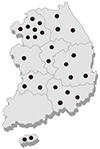Abstract
Objectives
The market for bottled water is increasing steadily in South Korea. Bottled water contains several naturally occuring minerals, such as calcium, magnesium, sodium, and fluoride. Fluoride is proven to be effective in preventing dental caries. In South Korea, the maximum permissible concentration of fluoride is 2 ppm for bottled water and 1.5 ppm for tap water. The aim of this study was to investigate the fluoride content of different commercially available brands of bottled water in South Korea, and compare the measured fluoride concentration to the concentration written on the label of each brand of bottled water.
Methods
Twenty-seven of the 59 different brands of bottled water produced in South Korea were investigated in this study. Three bottles of each brand were purchased from supermarkets, marts, and convenience stores in each region of Korea in August 2016. For each bottled water brand, the fluoride content was measured three times using a fluoride-ion selective electrode (Orion ionplus Fluoride Electrode 9609, Orion Research, USA). The calibration curve was generated using 0.2 and 2 ppm standard solutions, and confirmed using a 1 ppm standard solution.
Results
The mean fluoride content of the 27 brands of bottled water was 0.374±0.332 mg/L (range=0.040 to 1.172 mg/L). The fluoride content was labeled by the manufacturer, on each of the tested brands of bottled water. In eight brands, the labeled fluoride content differed from the experimental data. The minimum to maximum fluoride content measured from 10 brands showed a variation of 0.3 mg/L or more when compared to the labeled fluoride content.
Conclusions
This study investigated the fluoride content of various brands of bottled water produced in South Korea and compared the measured fluoride levels with fluoride information on the bottle labels. To ensure that consumers are suitably informed regarding their exposure to fluoride, correct labelling of fluoride content in bottled water is important.
Figures and Tables
References
1. World health organization. Fluorides and oral health. Geneva: World health organization;1994. p. 55–91.
2. Ten Cate JM, Van Loveren C. Fluoride mechanisms. Dental Clinics of North America. 1999; 43:713–742.
3. Ahiropoulos V. Fluoride content of bottled waters available in Northern Greece. Int J Paediatr Dent. 2006; 16:111–116.

4. Ko JY. Water communication. Seoul: Skbooks;2013. p. 16–21.
5. RA WC. Analysis of the Chinese bottled water market and export strategy for Korean firms. Korea Trade Rev. 2014; 39:77–108.
6. bottled water [Internet]. Moneytoday. cited 2018 Aug 07. Available from: http://news.mt.co.kr/mtview.php?no=2016081014173877316.
7. Bottled water manufacturers [Internet]. Ministry of environment: cited 2018 Aug 08. Available from: http://www.me.go.kr/home/web/policy_data/read.do?pagerOffset=0&maxPageItems=10&maxIndexPages=10&searchKey=title&searchValue=%EC%83%98%EB%AC%BC&menuId=10264&orgCd=&condition.deleteYn=N&seq=6752.
8. Standard of spring water [Internet]. Korea ministry of government legislation;cited 2018 Aug 08. Available from: http://www.law.go.kr/LSW/admRulLsInfoP.do?admRulSeq=2100000015163.
9. Water quality standard [Internet]. Korea ministry of government legislation;cited 2018 Aug 08.
10. Weinberger SJ. Bottled drinking waters: are the fluoride concentrations shown on the labels accurate? Int J Paediatr Dent. 1991; 1:143–146.

11. Toumba KJ, Levy S, Curzon ME. The fluoride content of bottled drinking waters. Br Dent J. 1994; 176:266–268.

12. So YR, Baik BJ, Kim JG, Yang YM, Kim HN. The study for the mineral contents of bottled water. J Korean Acad Pediatr Dent. 2009; 36:404–411.
13. Dobaradaran S, Mahvi AH, Dehdashti S. Fluoride content of bottled drinking water available in Iran. Fluoride. 2008; 41:93–94.
14. Cochrane NJ, Saranathan S, Morgan MV, Dashper SG. Fluoride content of still bottled water in Australia. Aust Dent J. 2006; 51:242–244.

15. Dean HT. Chronic endemic dental fluorosis (Mottled enamel). J Am Med Assoc. 1936; 107:1269–1273.
16. Hodge HC. The concentration of fluorides in drinking water to give the point minium caries with maximum safety. J Am Dent Assoc. 1950; 40:436–439.

17. Bailey K, Chilton J, Dahi E, Lennon M, Jackson P, Fawell J. Fluoride in drinking-water (World health organization). London: IWA Publishing;2006. p. 1–39.
18. US department of health and human services federal panel on community water fluoridation. US public health service recommendation for fluoride concentration in drinking water for the prevention of dental caries. . Atlanta: US department of health and human services federal panel on community water fluoridation;2015. 130:p. 1–14.
19. Featherstone JDB. Delivery challenges for fluoride, chlorhexidine and xylitol. BMC Oral Health. 2006; 6:S8.

20. From the Centers for Disease Control. Public Health Service report on fluoride benefits and risks. JAMA. 1991; 266:1061–1062. 1066–1067.
21. Ekstrand J, Ziegler EE, Nelson SE, Fomon SJ. Absorption and retention of dietary and supplemental fluoride by infants. Advances in Dental Research. 1994; 8:175–180.

22. Wiatrowski E, Kramer L, Osis D, Spencer H. Dietary fluoride intake infants. Pediatrics. 1975; 55:517–522.




 PDF
PDF ePub
ePub Citation
Citation Print
Print






 XML Download
XML Download